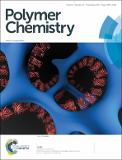Effect of polymer chemistry on globular protein–polymer block copolymer self-assembly
Author(s)
Chang, Dongsook; Tang, Shengchang; Olsen, Bradley D.; Lam, Christopher Nguyen
DownloadOlsen_Effect of polymer.pdf (1.335Mb)
PUBLISHER_CC
Publisher with Creative Commons License
Creative Commons Attribution
Terms of use
Metadata
Show full item recordAbstract
Bioconjugates of the model red fluorescent protein mCherry and synthetic polymer blocks with different hydrogen bonding functionalities show that the chemistry of the polymer block has a large effect on both ordering transitions and the type of nanostructures formed during bioconjugate self-assembly. The phase behaviours of mCherry-b-poly(hydroxypropyl acrylate) (PHPA) and mCherry-b-poly(oligoethylene glycol acrylate) (POEGA) in concentrated aqueous solution show that changes in polymer chemistry result in increase in the order–disorder transition concentrations (C[subscript ODT]s) by approximately 10–15 wt% compared to a previously studied globular protein–polymer block copolymer, mCherry-b-poly(N-isopropylacrylamide) (PNIPAM). The C[subscript ODT]s are always minimized for symmetric bioconjugates, consistent with the importance of protein–polymer interactions in self-assembly. Both mCherry-b-PHPA and mCherry-b-POEGA also form phases that have not previously been observed in other globular protein–polymer conjugates: mCherry-b-PHPA forms a cubic phase that can be indexed to Ia[bar over 3]d and mCherry-b-POEGA displays coexistence of lamellae and a cubic Ia[bar over 3]d structure over a narrow range of concentration and temperature. Several common behaviours are also revealed by comparison of different polymer blocks. With increasing concentration and temperature, ordered phases always appear in the order lamellar, cubic/PL, and hexagonal, although not all phases are observed in all materials. High concentration solutions (near 80 wt%) also undergo a re-entrant order–disorder transition to form nematic liquid crystalline phases, regardless of the polymer block chemistry.
Date issued
2014-06Department
Massachusetts Institute of Technology. Department of Chemical EngineeringJournal
Polymer Chemistry
Publisher
Royal Society of Chemistry
Citation
Chang, Dongsook, Christopher N. Lam, Shengchang Tang, and Bradley D. Olsen. “Effect of Polymer Chemistry on Globular Protein–polymer Block Copolymer Self-Assembly.” Polym. Chem. 5, no. 17 (2014): 4884–4895. © Royal Society of Chemistry
Version: Final published version
ISSN
1759-9954
1759-9962